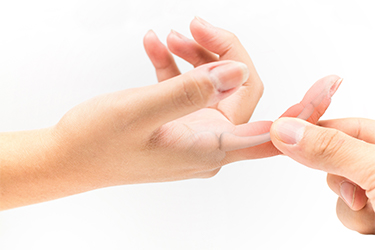

Trigger Finger
GENERAL INFORMATION
Trigger finger is a condition where one or more fingers become stuck in a bent position or bend and straighten with a snap, like a trigger being pulled and then released. To help people make informed decisions for their health and dispel any concerns they have regarding joint or tendon injury in their thumbs, hands, or fingers, we’ve provided the detailed information below.
For more information visit the American Academy of Orthopaedic Surgeons website
Trigger Finger Overview
Also known as stenosing tenosynovitis, trigger finger happens when inflammation narrows the space within the sheath surrounding the tendon in the finger or thumb suffering from the condition. It essentially causes the finger or thumb to get stuck in a bent position as if squeezing a trigger, and while it can occur in multiple fingers or in either thumb, it is most common in the ring finger.
What Causes Trigger Finger?
In the hand, tendons and muscles work together to flex and straighten the fingers and thumbs. Tendons are the band of tissue that connect muscles to bones and can slide through a tunnel of tissue called a sheath which keeps the tendons in their proper place next to the bones.
Trigger finger is when the tendons have swollen or become inflamed to the point where they can’t slide through their sheaths as easily as they’re supposed to. This is usually caused by repetitive gripping actions that occur in the course of a job or hobby, but can also occur among people suffering from diabetes.
Symptoms of Trigger Finger
The symptoms that trigger finger patients experience can range from mild to severe and can progress from one to the other, they include:
- Stiffness in the finger, especially when waking up
- Tenderness or a bump in the part of the palm that is at the base of the affected finger
- Popping or clicking feeling when the finger is moved
- The affected finger catches or locks into a bent position, followed by popping straight suddenly.
- Being unable to straighten the finger
- Inability to completely flex the finger
- Soreness at the base of the affected finger or thumb, especially while gripping or grasping
It’s important to repeat that these symptoms can appear in any finger or thumb that is suffering from the condition, sometimes multiple digits.
Trigger Finger Treatment
For a trigger finger treatment, it depends on the severity of the condition. For more mild cases, a doctor would recommend limiting or avoiding activities that are causing the symptoms and to rest the finger or thumb affected by the condition. Another treatment a doctor may recommend is placing the finger or thumb in a splint to keep the joint from moving and may prescribe anti-inflammatory medications or a trigger finger injection, namely a steroid.
If the health of the hand isn’t restored via rest and an injection, surgery may be recommended. The surgery can be performed under local anesthesia, meaning you’ll be awake for the procedure. Usually, it does not require a stay in the hospital. During the surgery, a tiny cut is made in the sheath where the affected tendon passes. The doctor widens the sheath to allow the tendon to slide more easily through it. This surgery is known to restore the finger or thumb’s ability to bend and straighten without the symptoms or pain.
The recovery time is usually a couple of weeks but can vary depending on the patient’s general health, their age, and the length of time the symptoms have been present.

